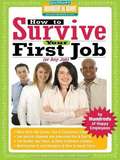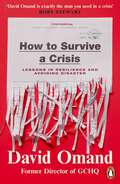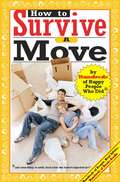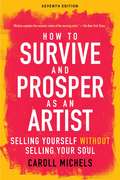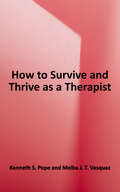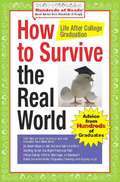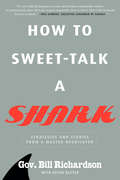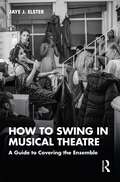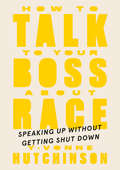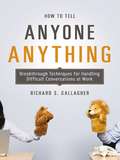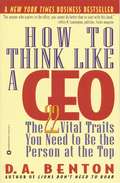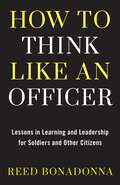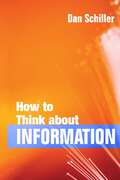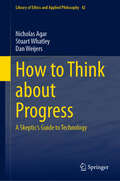- Table View
- List View
How to Survive Your First Job or Any Job
by Ricki FrankelIn this informational and necessary book, hundreds of gainfully employed young people detail their experiences launching their careers. They offer real-world tips and advice on looking for and landing a first job, doing well at work, and simply hanging in there. Their stories cover the gamut of work life - dealing with difficult bosses, weird coworkers, less-than-ideal environments and tasks, and climbing up (or slipping down) the corporate ladder, from those who have been there, done that, and lived to tell about it.
How to Survive a Crisis: Lessons in Resilience and Avoiding Disaster
by David Omand'David Omand is exactly the man you need in a crisis' RORY STEWART From the former Director of GCHQ comes a guide to surviving crises using the latest intelligence strategiesWar, terrorism, cyberattack, climate change, the threat of AI: it has never been more important to be prepared for the crises that await us.In How to Survive a Crisis, Professor Sir David Omand draws on his experience in defence, security and intelligence, including as Director of GCHQ and UK Security and Intelligence Coordinator, to show how you can detect a looming crisis and extinguish it (or at least survive it with minimum loss).Using gripping real-world examples from Omand's storied career, and drawing lessons from historic catastrophes such as Chernobyl, 9/11, the Deepwater Horizon oil spill and the WannaCry ransomware cyberattack, this empowering book is filled with practical advice on how to survive the multiplying crises of the future. Not every crisis need tip into disaster, if we have invested in we are prepared for it.'This book is the instruction manual we all need' SIR ALEX YOUNGER, CHIEF OF MI6UPDATED WITH A NEW FOREWORD
How to Survive a Move
by Jamie Allen Kazz RegelmanIf you are one of the forty million Americans who will move this year, you know the task can seem overwhelming. Now, there's help. How to Survive A Move offers hundreds of helpful and entertaining stories on moving from the real "pros"- everyday people who have moved (many of them over a dozen times!) and survived to tell their stories.Unlike other moving books that give the opinion of one or two experts, How to Survive a Move includes words of wisdom from hundreds of people - both singles and families, nationwide - who have "been there, done that." Millions of people have survived moving, and so can you!
How to Survive and Prosper as an Artist: Selling Yourself without Selling Your Soul (Seventh Edition)
by Carol Michels“Michels explodes the romantic notion of the starving artist.” —The New York Times “Michels is a tough but compassionate advocate, savvy in the ways of the world and the demands on artists in this materialistic society.” —The Miami Herald Written for fine artists ready to launch their careers as well as experienced artists who wish to relaunch their careers, How to Survive and Prosper as an Artist, Seventh Edition, an acclaimed guide, empowers artists to take control of their careers to create a fulfilling life and earn a decent income. In this newly revised edition, Caroll Michels continues to demystify the inner workings of the art world and challenge the status quo. New chapters discuss such topics as: New business models for artists: Going to the extreme The use of social media and website development as marketing and publicity tools and what does and doesn’t work The confusion between the “art-buying public” and the “general public” and their differences New suggestions for establishing and calculating prices for artwork Neighborhood gentrification and the growing challenges of securing a reasonably priced live/work space How dealers find artists, how to negotiate with dealers, and how to understand a dealer’s agenda Using her own experiences as an artist as well as the experiences of her clients, Michels crafts a must-read guidebook for anyone interested in embarking upon a successful career as an artist.
How to Survive and Thrive As a Therapist: Information, Ideas, and Resources for Psychologists in Practice
by Kenneth S. Pope Melba J.T. VasquezThis book is a nuts-and-bolts guide to starting, growing, or improving a psychotherapy practice. Graduate psychology programs offer a wealth of information on honing one's therapeutic skills, but often provide little information on the "how to's" of practice: creating a successful business plan; tailoring your practice to suit your needs, talents, and values; marketing your services; finding an office that works for you and your clients; developing forms, policies, and procedures; finding the right attorney and professional liability insurance; responding to licensing, malpractice, or ethics complaints; using computers safely, efficiently, and effectively; and; taking care of yourself so you can provide the best possible service to your clients. All of these topics are covered in this book. <p><p>Both psychologists just starting out and seasoned practitioners who want to expand, restructure, or enrich their practices will appreciate the authors' wit and wisdom. In addition to the 15 chapters, the book contains 15 appendices that make key APA professional standards and guidelines and other resources available for consultation in one handy source.
How to Survive and Thrive During the Collapse of the Welfare State
by James N. Davidson Lord William ReesmoggEconomic and social analysis.
How to Survive in a Scale-Up Business: Master the Human Skills Needed to Thrive in Young, High-Growth Businesses
by Vidya MuraliWorking in a scale-up is exciting, but it can also be exhausting. This book is your emotional survival kit for succeeding in a fast-paced and unpredictable environment.Scale-ups attract ambitious, driven and hardworking individuals seeking excitement, ownership, freedom and greater rewards. However, these opportunities often come with challenges. Understanding the emotional and behavioural patterns commonly seen in scale-ups – and learning from others’ experiences – can help you move from struggling to thriving.In this book, author Vidya Murali brings together: A personal scale-up suitability checklist to help assess and understand whether scale-ups are the right environment for you based on your skills and preferences Guidance on what to look for when interviewing, and how to set yourself up for success in the first 90 days Insights, frameworks and coaching questions to tackle toxic patterns commonly seen in scale-ups Real-life case studies from scale-up leaders with lessons and strategies Practical strategies for introverts, highly sensitive people, ethnic minorities and people with ADHD and/or dyslexia to thrive in scale-ups Tools for building your emotional skills to progress and thrive in scale-ups – including if you lose your job or face a mental health breakdown A must-read for anyone transitioning into scale-ups or already working in one, this book will be of immense interest to graduates seeking their first full-time role, professionals transitioning from corporate environment, leaders – including founders – as well as HR professionals and coaches.
How to Survive in an Organization
by James HeapheyJim Heaphey unravels the layers of organizational life exposing the myths upon which corporations and organizations rely for their very existence. Examined are the dual myths of management wisdom and performance evaluation. Examined also is the makeup of people in groups and the human condition; the nature of power; and the managerial tactics of manipulation used to control people singularly or in the group. The author presents tactics and strategies for dealing with all of these aspects and more. How To Survive In An Organization is for the realist who is willing to look at organizational life as it really is and is anxious to find a way to survive and succeed.
How to Survive the Real World: Life After College Graduation
by Andrea SyrtashAfter the parties, the frat rushes, the Big Test and the Big Game, the caffeinated all-nighters, and the pomp and circumstance, life comes knocking. Finding a job and keeping it; renting an apartment or sharing a sublet; dealing with your own money instead of your parents' money; looking for love (and looking and looking . . . ): who knew how complicated the world after college would be? Nearly 800 contributors to this How to Survive book found out, and happily share their hard-won insights. This useful, upbeat book collects stories, tips, and advice on finding the best place to live, entering adulthood without losing passion, taking care of one's health, finding a great job, and not going home for the holidays for the first time. Covering both the psychological adjustments and the nuts and bolts of daily life as a grown-up, How to Survive the Real World is witty, practical, and the perfect gift for the nervous grad.
How to Sweet-Talk a Shark: Strategies and Stories from a Master Negotiator
by Kevin Bleyer Bill RichardsonSharks are not evil. But they're single-minded and very, very hungry. On land, they take the form of bosses, businesspeople, colleagues, family, and sociopathic neighbors. In the world of former governor of New Mexico and US ambassador to the United Nations Bill Richardson, they have taken the form of the most powerful people in the world. He's engaged in high-stakes, face-to-face negotiations with Castro, Saddam, the Taliban, two generations of North Korean leadership, and many more of the world's most infamous dictators—and done it so well he was known as the "Undersecretary of Thugs" while with the Clinton administration. Now the 5-time Nobel Peace Prize nominee tells these stories—from Washington, DC, to the Middle East to Pyongyang—in all their intense and sometimes absurd glory.How to Sweet-Talk a Shark is a rare, candid, and entertaining glimpse into an insider's world of high-stakes negotiation—showing Richardson's successes and failures in some of the world's least friendly places. Meanwhile, readers get frank lessons in the art of negotiation: how to prepare, how to size up your opponent, how to understand the nature of power in a standoff, how to give up only what is necessary while getting what you want, and many other strategies Richardson has mastered through at-the-table experience—and from working with other master negotiators like Presidents Obama and Clinton, and Nelson Mandela. These are takeaways that anyone can use to negotiate with the power brokers, dealmakers, and, yes, the hungry sharks in their own lives.
How to Swing in Musical Theatre: A Guide to Covering the Ensemble
by Jaye J. ElsterHow to Swing in Musical Theatre shines a light on the most universal techniques used by cast members who, in response to absence, can perform multiple roles across an ensemble. This entertaining guide can be used not only to build a step-by-step understanding of what swinging is and how it can be approached, but also as a constant point of reference throughout a career in musical theatre. Providing a suite of practical, technical advice on everything from quick and easy notation to compiling one’s own personal swing ‘bible’, everything that an aspiring or experienced musical theatre performer will need is clearly arranged and thoughtfully explained. This book also teaches the SAFE Strategy, which is recognised as the most functional swing method and introduces the SAFE Principles of Swinging: Safety, Awareness, Function and Evolution. The principles are an original construct, devised to ward off stress and invite positive experience through reasoned behaviours. Musical theatre performers at every level of the profession will find this an invaluable guide that elevates their craft no matter what their previous training, experience or success in the industry.
How to Talk So People Listen: Connecting in Today's Workplace
by Sonya Hamlin“Provides thought-provoking insights and workable solutions to communicating with others in a changing world. . . . Highly recommended.” —Library Journal, starred reviewAt a time when it’s harder than ever to get and keep people’s attention, we could all use some help. Enter Sonya Hamlin, author of the now classic How to Talk So People Listen, and one of America’s leading communication experts. In this revised and updated edition, Hamlin shows us how to successfully capture people’s attention so that they listen, understand, and are persuaded by your message –– especially in the plugged–in, fast–paced, visually–driven atmosphere that is today’s workplace.Whether making a presentation to a large audience, dealing one–on–one with a client or colleague, or communicating by email, Hamlin teaches us that one of the keys to making people listen is to think about and respond to what motivates them—namely, self–interest. She then provides tools to assess others’ self–interest and use it to get them to listen to your message. Hamlin also explains how to capitalize on the latest visual aids we have at our disposal today. We learn to determine what information needs or lends itself to visual presentation, and how to make visuals active, so that they serve as an extension of the speaker. In How To Talk So People Listen, you’ll also find practical information on how to understand your audience, how to encourage your listeners to trust you, and how to be yourself when you’re on the podium.“A compendium of tested techniques that can help readers to improve communication on the job and elsewhere.” —Publishers Weekly
How to Talk Your Way to Success
by Harry SimmonsHave you ever stopped to think how much “talk” occurs in our own little busy world every day of our lives?Do you realize how much talk is involved in our jobs in everyday business? How everything we do every day of our lives involves conversation and speech on many different topics?Our conversations in our household and community affairs, at our desk in the office, out in the factory or on the road, with our fellow workers, executives, vendors, customers, visitors, friends—all these involve thousands of words every day in our lives.Imagine what help it might be to your prospects of success if all your talk and conversation were consciously directed to specific objectives and goals of accomplishment. Think of the pleasant and desirable things that might happen if your talks, your conversations, your letters, your telephone messages, your public appearances all were consciously channeled along the road to success.This book has as its major purpose the directing of all these words into proper, efficient, and effective lines of communication.
How to Talk to Anyone at Work: 72 Little Tricks for Big Success Communicating on the Job
by Leil LowndesFrom the bestselling author of How to Talk to Anyone comes a book dedicated to helping business professionals at any level communicate for success on the job <p><p> You face tough communication challenges every day at work, both in person and online—a toxic boss, backstabbing coworkers, office politics, and much more. Here are immediate, effective, eye-opening actions you can take to resolve those infuriating problems. You will find stories and examples drawn from corporate communications consultant Leil Lowndes’s more than 20 years of training business professionals, from entry-level new hires to CEOs. To succeed today, you must exhibit these crucial qualities, the 5 Cs: <p><p> CONFIDENCE 10 ways to show your boss and colleagues you are 100 percent self-assured and can achieve whatever you want—and reinforce this image throughout your entire working relationship <p><p> CARING 14 strategies to demonstrate you care about your colleagues and the company because “people don’t care how much you know until they know how much you care” <p><p> CLARITY 12 techniques to get your ideas across clearly—and ensure you understand everybody you work with <p><p> CREDIBILITY 14 methods to win the trust and respect of everyone at your company—and impress people who find you on the web <p><p> COEXISTENCE (WITH CRUEL BOSSES & CRAZY COLLEAGUES) 21 tactics to confront the number one workplace nightmare and come out shining <p><p> Plus one final astonishing technique to guarantee success and happiness in your professional life. After you’ve mastered the unique “bag of little tricks” in this book, you will know How to Talk to Anyone at Work!
How to Talk to Customers: Create a Great Impression Every Time with MAGIC
by Tom Larkin Diane BerenbaumFilled with case studies and anecdotes, How to Talk to Customers demystifies the most critical aspect of customer service: conversations employees have every day with customers. In this must-have resource, Diane Berenbaum and Tom Larkin outline a proven system based on their MAGIC customer service training program. MAGIC, which stands for Make A Great Impression on the Customer, can help anyone become the type of communicator that makes their customers feel special. For more on this book, visit www.howtotalktocustomers.com
How to Talk to Your Boss About Race: Speaking Up Without Getting Shut Down
by Y-Vonne HutchinsonAn indispensable practical toolkit for dismantling racism in the workplace without fearReporting and personal testimonials have exposed racism in every institution in this country. But knowing that racism exists isn&’t nearly enough. Social media posts about #BlackLivesMatter are nice, but how do you push leadership towards real anti-racist action?Diversity and inclusion strategist Y-Vonne Hutchinson helps tech giants, political leaders, and Fortune 500 companies speak more productively about racism and bias and turn talk into action. In this clear and accessible guide, Hutchinson equips employees with a framework to think about race at work, prepares them to have frank and effective conversations with more powerful leaders, helps them center marginalized perspectives, and explains how to leverage power dynamics to get results while navigating backlash and gaslighting. How to Talk To Your Boss About Race is a crucial handbook to moving beyond fear to push for change. No matter how much formal power you have, you can create antiracist change at work.
How to Teach Economics to Your Dog: A Quirky Introduction
by Rebecca Campbell Anthony McGowanMonty is a dog, not a financial genius, but economics still shapes his everyday life. Over the course of seventeen walks, Dr Rebecca Campbell chews over economic concepts and investigates how they apply to our lives – people and mutts alike. There are no graphs, no charts (Monty can&’t read them) and definitely no calculus! How to Teach Economics to Your Dog tackles the knotty question of what economics actually is. Is it a mathematical science like physics? Or a moral and philosophical investigation of how societies should manage scarce resources? Along the way we meet some of the great thinkers from Adam Smith to Thomas Piketty, and ponder questions such as: What on earth does quantitative easing mean? And why are some countries so much richer than others?
How to Tell Anyone Anything: Breakthrough Techniques for Handling Difficult Conversations at Work
by Richard GallagherNo one likes to be criticized, but this book teaches the communication skills needed to successfully get the message across while keeping feelings and relationships intact.Drawing from the latest in psychology on how best to connect with others, How to Tell Anyone Anything steers you away from the common mistake of providing feedback by focusing on what&’s wrong and shows you instead how to provide clear, constructive positive messages that create real behavior and performance change.You&’ll learn how to:be more candid,prioritize relationships,ask important questions,reframe difficult messages,control your emotions,and be graceful when you&’re on the receiving end of difficult feedback.Complete with illuminating examples and a unique step-by-step process, How to Tell Anyone Anything gives you powerful insight into how we all react naturally to criticism--and how to transform interactions that might become verbal tugs-of-war into collaborative problem-solving sessions.
How to Think Deeply: A Brief Guide to Overcoming Your Depth Deficit
by Gerald Zaltman Lindsay ZaltmanThis chapter identifies a deficit in deep thinking among managers and discusses some factors contributing to this deficit, particularly managers' tendencies to overemphasize surface-level differences among consumers and to neglect the deep metaphors that enable us to observe such differences in the first place.
How to Think Like a CEO: The 22 Vital Traits You Need to Be the Person at the Top
by D. A. BentonDrawing on in-depth interviews with hundreds of the nation's top executives, D. A. Benton explains the 22 vital traits that make a CEO - the leader responsible for making decisions, guiding teams, selling ideas, managing crises, and conquering the mountains before them. You'll penetrate the mystery of why some people make it to the top and some don't, when they're all equally good at their jobs. You'll learn how to avoid getting fired and how to get promoted more quickly, how to enjoy the quality of life you want and deserve, and - if you decide you want to be the Big Boss - how to have the right character traits to get there. These are some of the traits that make a CEO. Are you ready to make them yours? You're gutsy and a little wild - yet modest and in control. You're competitive and tenacious - yet flexible and generous. You're willing to admit mistakes - yet unapologetic. You're secure in yourself - yet constantly improving. You're original and straightforward - yet think before you talk. Make your ascent not only gratifying, but also exhilarating and fun. This is how chiefs run the show - and how you can act like a chief to become a chief, even sooner than you dreamed.
How to Think Like an Officer: Lessons in Learning and Leadership for Soldiers and Citizens
by Reed BonadonnaThe U.S. military invests heavily in time and resources to train its officers to be leaders in the broadest sense – forming them not only in military art and science (strategy, tactics, command, etc.), but also in humanistic knowledge, character, and values, as well as how to apply this education on a lightning-fast battlefield or within an inertially slow bureaucracy. The military develops its leaders, at the service academies and in ROTC programs, through very specific but also broad and deep education – a way of thinking that also has wide application in the civilian world, not only in various professional fields that need leaders and thinkers, but also among military history enthusiasts who want to understand how officers have thought across time and among American citizens who want – and, really, need – to understand how our military leaders think, how they advise presidents, how they lead on the battlefield.In a genre-busting book that spans Stackpole&’s two longstanding military programs – reference and history – Reed Bonadonna describes how officers think, how they ought to think, how they develop their skills, and how they can improve these skills, as well as how average civilians and citizens can learn from the example of military officers and their program of education. Bonadonna draws from military history, from military arts and science, from literature and science and more, to show how officers develop their critical-thinking and problem-solving skills. A military officer is often called upon to be not only fighter and leader, but also negotiator, organizer, planner and preparer, teacher, writer, scientist, and advisor, and needs broad learning. This is a deeply learned and insightful book, one that cites Lincoln, Grant, Patton, Eisenhower, Marshall, and Churchill as easily as Sun Tzu and Clausewitz, not to mention Homer, Plato, Joseph Conrad, Henry James, Wilfred Owen, Robert Graves, George Orwell, Ludwig Wittgenstein, Joseph Heller, Phil Klay, and even Jane Austen. The book is descriptive as well as prescriptive and should find eager readers inside the military (where officers take seriously their professional education and their professional reading lists) as well as outside, where many look to the military, to military reading lists, and to military history, to glean lessons for life and work.
How to Think about Information
by Dan SchillerIt is common wisdom that the U.S. economy has adapted to losses in its manufacturing base because of the booming information sector, with high-paying jobs for everything from wireless networks to video games. We are told we live in the Information Age, in which communications networks and media and information services drive the larger economy. While the Information Age may have looked sunny in the beginning, as it has developed it looks increasingly ominous: its economy and benefits grow more and more centralized--and in the United States, it has become less and less subject to democratic oversight. Corporations around the world have identified the value of information and are now seeking to control its production, transmission, and consumption. In How to Think about Information, Dan Schiller explores the ways information has been increasingly commodified as a result and how it both resembles and differs from other commodities. Through a linked series of theoretical, historical, and contemporary studies, Schiller reveals this commodification as both dynamic and expansionary, but also deeply conflicted and uncertain. He examines the transformative political and economic changes occurring throughout the informational realm and analyzes key dimensions of the process, including the buildup of new technological platforms, the growth of a transnationalizing culture industry, and the role played by China as it reinserts itself into an informationalized capitalism.
How to Think about Progress: A Skeptic's Guide to Technology (Library of Ethics and Applied Philosophy #42)
by Nicholas Agar Stuart Whatley Dan WeijersHow to Think about Progress is an interdisciplinary work exploring whether optimistic claims about technology’s potential stand up to humanity’s most difficult challenges. Will technology solve the problems of climate change, pandemics, cancer, loneliness, unhappiness, and even death? The authors show that techno-hype is all too often accepted because of the horizon bias, i.e. the modern propensity to believe that any problem that can be solved with technology will be solved in the very near future. The authors situate their analysis in a broad context, drawing on history, literature, and popular culture to emphasize their case against techno-hype. They also draw on a wide range of research, including that of biologists, philosophers of science and of language, psychologists, theorists of technological change, specialists on digital technologies, historians of ideas, and economists. As a corrective to much mainstream “futurism,” the book offers principles for seeing through much of the techno-hype that circulates online and in best-selling books. The authors share insights (without the jargon) from a variety of academic disciplines, making this book an engaging read for all audiences. Readers will find a balanced framework for thinking and writing about technological progress in the face of truly vexing challenges like cancer, climate change, and colonizing mars.
How to Think and Design in the Third Dimension
by Paul JacksonFrom paper folding genius Paul Jackson comes his latest book How to Think and Design in the Third Dimension. We live in a 3-D world, but most three-dimensional objects are designed from a series of two-dimensional side elevations and plan views. This book will teach you how to think and design in the third dimension. Through 60 construction projects, you will learn how folded paper units can be joined to create beautiful 3-D structures, according to the principles of three-dimensional symmetry. In addition to over 80 specially commissioned photographs and 300 step-by-step illustrations, this accessible book contains QR codes or hyperlinks to 30 short videos that show a selection of the projects rotating through 360 degrees.With How to Think and Design in the Third Dimension by their side, anyone who creates in three dimensions, including designers of all specialities, sculptors, architects, engineers and craftspeople, will be able to design with a new, practical and infinitely creative language of form.
How to Think and Design in the Third Dimension
by Paul JacksonFrom paper folding genius Paul Jackson comes his latest book How to Think and Design in the Third Dimension. We live in a 3-D world, but most three-dimensional objects are designed from a series of two-dimensional side elevations and plan views. This book will teach you how to think and design in the third dimension. Through 60 construction projects, you will learn how folded paper units can be joined to create beautiful 3-D structures, according to the principles of three-dimensional symmetry. In addition to over 80 specially commissioned photographs and 300 step-by-step illustrations, this accessible book contains QR codes or hyperlinks to 30 short videos that show a selection of the projects rotating through 360 degrees.With How to Think and Design in the Third Dimension by their side, anyone who creates in three dimensions, including designers of all specialities, sculptors, architects, engineers and craftspeople, will be able to design with a new, practical and infinitely creative language of form.
